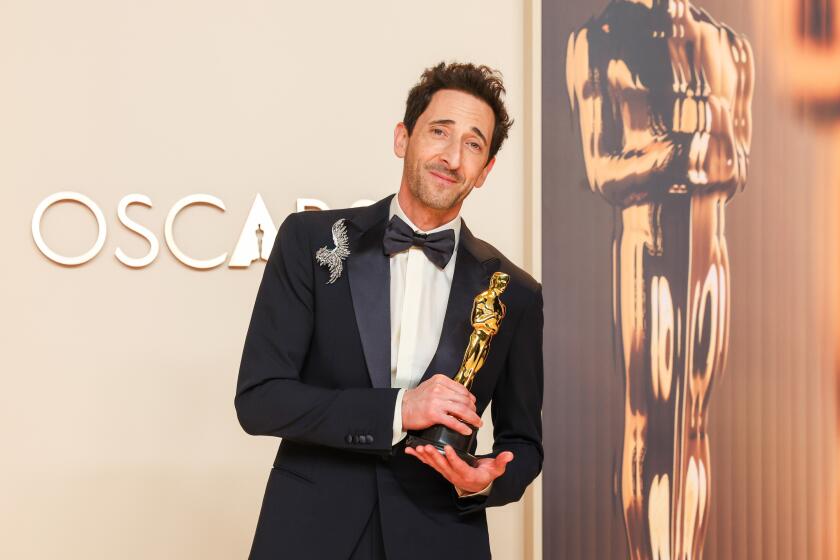A wing and a player
- Share via
The problem with American lives is not, as F. Scott Fitzgerald famously wrote, that they have no second acts -- it’s that the second acts tend to overshadow the first ones. So it was with Orson Welles, remembered as much for his weight and his wine commercials as for the cinematic genius of his prime, and for Howard Hughes, recalled as the demented recluse of his declining years and not as the significant Hollywood player and pioneering aviation visionary he was in his salad days.
If history has not been kind to Howard Hughes, then Hollywood has not been especially giving to Martin Scorsese. Yes, four of his films have been best picture nominees, and he’s been personally up for an Oscar six times, but the industry has stubbornly refused to give him or his films its ultimate honor.
To be fair to the motion picture academy, while Scorsese’s gifts are always in evidence, it’s been a while since the films themselves have been anything to write home about in terms of audience satisfaction. But now comes “The Aviator,” the director’s two hour and 49 minute look at a pivotal 20 years in Hughes’ life, which just might redress those balances.
This is very much a traditional wide-screen epic of the old school, the kind of meticulously executed extravaganza, complete with an all-star cast, that the director (whose knowledge of film history is exceptional) has admired for years. With Leonardo DiCaprio in the title role and lots of cameos (hey, isn’t that Jude Law as Errol Flynn!), it’s not without noticeable problems -- few films at that length are -- but it’s both impressive in a movie-movie way and able to overcome a weakness that has bedeviled Scorsese’s recent films.
Though what he does is invariably exquisite from a craft point of view, Scorsese has often had a tendency to be show-offy, to be there solely to please himself and overawe others. But in “Aviator” he’s put all his technique, energy and style at the service of a story we can’t look away from, at least initially. It’s a quintessentially American story, one that Fitzgerald would certainly recognize, a tale of sex, money, power, neuroses and Hollywood. And no ultraviolence in sight.
Despite this blessed absence of bodies in car trunks and heads in vises, there are several things in Hughes’ story (as refracted through John Logan’s well-crafted script) that Scorsese must have connected to, including a sheltered and illness-plagued childhood and a passion for perfectionism.
Some of these connections, like an endless fascination with just how crazy Hughes could get, eventually come back to haunt the film. But it’s their joint mania for the pure pleasure of making movies that gives Scorsese (who has given himself a voice cameo as a projectionist) a running start in tackling this boy’s life.
For Howard Hughes was little more than a boy, 22 in fact, when, after a brief prologue, DiCaprio takes up the role in 1927 as the producer/director of a World War I aviation drama called “Hell’s Angels.”
Opening with a bravura tracking shot that echoes the celebrated one in “Casino” (as other moments echo scenes from movies as varied as “New York, New York” and “Raging Bull”), this section of “Aviator” has both a ferocious sense of pace (Thelma Schoonmaker edited) and a sense of humor. We watch boy wonder Hughes throw himself into assembling the world’s largest private air force, hire a meteorologist (an amusing Ian Holm) to find cloudy skies to make his planes look better, and end up spending $4 million on what at the time was by far the most expensive feature ever made.
The Hughes of this section of the film is defined by practically the first words out of his mouth: “Don’t tell me it can’t be done.” Crisp, decisive, sure about what he wants and not shy about asking for it, he has a drive and strength of will so powerful he compels confidants like Noah Dietrich (John C. Reilly) and Glenn Odekirk (Matt Ross) to go along.
DiCaprio, an actor whose core does not seem as black as Hughes’ likely was, would not have been the consensus first choice to play the aviator, a role that Warren Beatty, Johnny Depp and others were considered for over the years. But, perhaps rising to the bait of the most dramatically challenging part he’s taken on in some time, DiCaprio convincingly conveys the hard shrewdness and the petulance of the man. It’s a make-or-break performance for the film, and it pays off.
Another make-or-break acting choice with more problematic results is Cate Blanchett’s take on Katharine Hepburn, posited by “The Aviator” as the love of Hughes’ life. Blanchett comes on so strong as Hepburn, unbending Yankee accent and all, that the performance is uncomfortably close to caricature and throws us out of the movie. Blanchett, the most accomplished of actresses, comes closer than anyone else could to making us buy this version of Hepburn, but there is so much conceptual dissonance in the attempt it cannot fully succeed.
Though he also dallied with Ava Gardner (an effective Kate Beckinsale), Hughes’ most sustained passion was always aviation, and “The Aviator” lives up to its name by spending considerable time on the ins and outs of Hughes’ spectacular flying career. He set significant personal flying records, helped design several landmark planes, including the enormous wooden cargo ship derisively and inaccurately (it was made of birch) nicknamed the Spruce Goose. He envisioned the flowering of commercial aviation and battled Pan American’s Juan Trippe (Alec Baldwin) and Sen. Owen Brewster (a delicious Alan Alda cameo) over who should control the skies.
A joy in the physical side of movie-making is one of “The Aviator’s” strongest suits. Notable are its re-creation of the glamour and musicality of the Cocoanut Grove nightclub (Dante Ferretti is the production designer) and the director’s decision to mimic the look of the two-strip and three-strip Technicolor film processes that were the norm in Hughes’ day (credit cinematographer Robert Richardson).
Detracting from all this good work, however, is Scorsese’s decision, inevitable but regrettable, to spend large amounts of time on the spectacle of Hughes slowly but surely going mad. Given the psychological kinship the director seems to feel for a fellow obsessive, as well as how exciting the mad scenes were for DiCaprio to act in (he called them “the greatest of memories making this film”), there was likely no way out of these extended sequences depicting Hughes’ manias and compulsions in loving detail. There is also no avoiding the conclusion that the film loses energy and interest in these sequences, falling prey to the trap of uninvolving self-indulgence that the director has successfully avoided elsewhere.
When he was a boy, the story goes, Howard Hughes vowed he’d grow up to fly the fastest planes ever built, make the biggest movies ever made and be the richest man in the world. The fascination of his life is not that he did it all but that the poisons in his mind made it almost beside the point. Still, tainted or not, Hughes’ life was a remarkable one, and, flawed or not, Scorsese’s film version deserves the same accolade.
*
‘The Aviator’
MPAA rating: PG-13
Times guidelines: Sexual situations, a realistic crash
Leonardo DiCaprio ... Howard Hughes
Cate Blanchett ... Katharine Hepburn
Kate Beckinsale ... Ava Gardner
John C. Reilly ... Noah Dietrich
Warner Bros. Pictures and Miramax Films present a Forward Pass Inc./Initial Entertainment Group production. . Director Martin Scorsese. Producers Michael Mann, Sandy Climan, Graham King, Charles Evans Jr. Executive producer Chris Brigham. Screenplay John Logan. Running time: 2 hours, 49 minutes.
In general release.
More to Read
Only good movies
Get the Indie Focus newsletter, Mark Olsen's weekly guide to the world of cinema.
You may occasionally receive promotional content from the Los Angeles Times.











